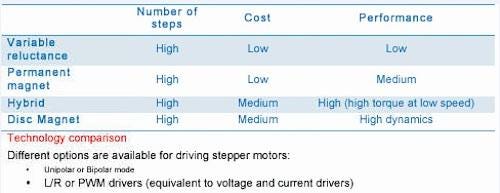Choosing the Best Technology for Your Application
August 4, 2014

To solve motion applications, most engineers choose between stepper or servo motors. These motors have their own characteristics depending on their design and the way they are driven. The selection is often made by reviewing the existing solution. To optimize the solution in terms of cost and performance, it's important to have the ability to explore all existing technologies as well as a custom design solution.
Stepper motor
A stepper motor is an electric motor which by design has many stable positions per revolution and per phase. These motors typically have two, three, or five phases and are often driven open loop. The current in the phases is applied and we expect the rotor to follow the magnetic flux created by the coil. As the system is open loop, we always need to work with a safety factor to ensure rotor will follow the magnetic field created by the coils.
Many engineers believe it is easier to drive a stepper motor than a servo, which is correct as long as we do not require fast motion. In this case, the acceleration ramp has to be optimized and a safety factor applied to avoid losing steps during movement.
On the market there are different technologies of stepper:
Variable reluctance
Permanent magnet
Hybrid
Disc Magnet
Each of these above technologies has advantages that we can summarize (see table 1).

According to the way the current is controlled in each coil, we can drive the motor in full step, half step or micro stepping.
By design these motors have a high number of poles to enable high resolution, since they are driven open loop. This high number of poles has benefits but also drawbacks:
Benefits:
High number of steps/revolution (no need for encoder for positioning)
High stiffness at position
High torque density at low speed
Drawbacks:
High number of commutation per revolution
High inductance effect at high speed
Significant iron losses at high speed
Importance reactive power means increased driver size
Lack of torque output at high speed
Brushless Dc Servo motors
A Brushless (BLDC) Servo motor typically has three phases, a low number of poles, and use the rotor position feedback to trigger the current in the phases. The position feedback can either be a magnetic encoder (hall sensors), an optical encoder, a magneto resistive encoder, or a resolver. BLDC Servo motors have a low number of poles and therefore a low number of commutation per revolution with limited iron losses, allowing them to go at high speed (> 10Krpm).
Different technologies are used for BLDC motors.
BLDC slotted (coil winded in slots)
BLDC slotless (no slot at the stator)
BLDC ironless at the stator
These three technologies have their own benefits and drawbacks as summarized below:
BLDC Slotted:
robust winding design
low thermal resistance
medium iron losses at high speed
detent torque
BLDC Slotless
low iron losses at high speed
takes full advantage of rare earth magnets
no detent torque
BLDC Ironless at the stator
low iron losses
low torque density
no detent torque
About the Author(s)
You May Also Like





